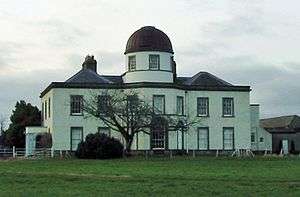Ireland lunar sample displays
The Ireland lunar sample displays are two commemorative plaques consisting of small fragments of moon rock brought back to earth by the Apollo 11 and Apollo 17 lunar missions and given to the people of Ireland by United States President Richard Nixon as goodwill gifts.[1][2]
Apollo 11 samples
The Apollo 11 lunar sample display commemorative podium style plaque given to Ireland, once housed at the Dunsink Observatory in Dublin, consisted of four moon rock fragments – rice-size particle specimens that were collected by Apollo 11 astronauts Neil Armstrong and Buzz Aldrin in 1969 – and a small flag that was taken to the moon and back on Apollo 11.[1]
The four fragments weighed about 0.05 grams in total and were entirely enveloped in a clear plastic ball the size of a coin, mounted on a wooden board approximately one foot square on a small podium pedestal display. The display also had a small Irish flag mounted on it that had gone to the moon and back on Apollo 11. The display was given to the people of Ireland as a gift by United States President Richard Nixon. Similar lunar sample displays were distributed to the 50 states of the United States and to the countries of the world.[1]
Loss

This display was placed in the Meridian room of the Dunsink Observatory in Dublin, which was used as a library, and exhibited alongside an eighteenth-century orrery.[3]
Shortly after 1 a.m. on the morning of 3 October 1977, a fire broke out in the basement under the Meridian room. The cause of the fire was unknown but the fire brigade speculated that it could have been an electrical fire, while other speculation considered suggested it might have been a robbery with arson to disguise it.[3]
The fire debris was removed to the dump at the Finglas landfill, across the street from the observatory. The lunar display was among this rubble and was accidentally thrown away. The odds of recovering them in the landfill are said to be greater than a "needle in a haystack". Joseph Gutheinz, a former NASA employee and self-appointed private investigator of the Apollo moon rock displays, values these fragments at $5 million.[4][5] The discarded moon rocks have been referred to as a "pot of gold under a dump".[4][6][7]
Apollo 17 samples

The Apollo 17 lunar sample display commemorative plaque (10 by 14 inches) given to Ireland consists of one moon rock fragment that was cut from lunar basalt 70017. The sample was collected on the moon by Apollo 17 astronaut Harrison Schmitt in 1972. It was cut into one-gram fragments back on earth and this specimen was enveloped in a plastic ball and mounted on a wooden plaque along with Ireland's flag, which had been taken to the moon and back on Apollo 17. The plaque was sent to Ireland by Richard Nixon in 1973[2] and is in the National Museum of Ireland in Dublin.[8]
References
- 1 2 3 Pearlman, Robert (1999–2012). "Where today are the Apollo 11 goodwill lunar sample displays?". CollectSPACE.com. Retrieved 2 November 2012.
- 1 2 Pearlman, Robert (1999–2012). "Where today are the Apollo 17 goodwill lunar sample displays". collectspace.com. Retrieved 2 November 2012.
- 1 2 Wayman, P.A. (3 October 1977). "Dunsink Observatory – Outbreak of fire". Irish Astronomical Journal. SAO/NASA Astrophysics Data System (ADS). 13: 156. Bibcode:1978IrAJ...13..156W. Retrieved 2 November 2012.
- 1 2 Bosworth, Mark (20 February 2012). "What has happened to Nasa's missing Moon rocks?". BBC. Retrieved 2 November 2012.
- ↑ meganspecia (20 February 2012). "Missing Moon Rock Lost in Finglas Landfill". BBC World. Retrieved 2 November 2012.
- ↑ "Unde e averea din cer?" [Where is the wealth of heaven?] (in Romanian). www.jurnalul.ro. 9 November 2009. Retrieved 13 November 2012.
- ↑ Earth, March 2011, pp. 42–51
- ↑ Twomey, Aoibhinn (27 February 2012). "Five million dollar rock lost in Dunsink". Dublin People. Retrieved 15 November 2012.
Further reading
- Kloc, Joe (19 February 2012). The Case of the Missing Moon Rocks. The Atavist/Amazon Digital Services, Inc. p. 47. ASIN B007BGZNZ8.
External links
| Wikimedia Commons has media related to Wooden plaques. |
